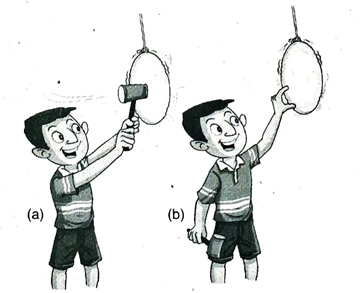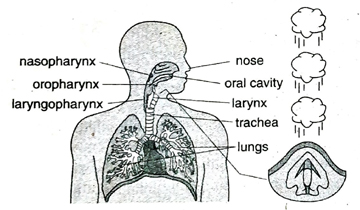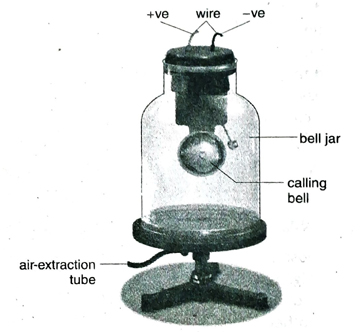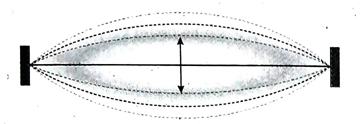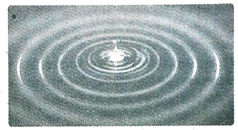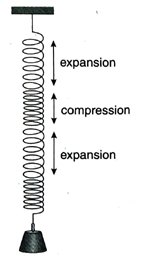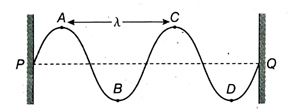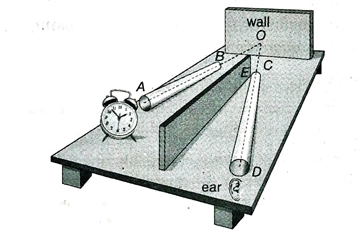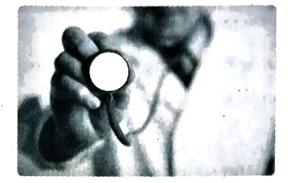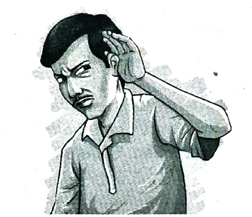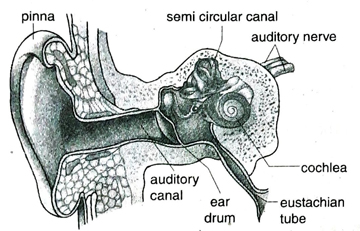WBBSE 9th Class Science Solutions Physical Science & Environment Chapter – 7 Sound
West Bengal Board 9th Class Science Solutions Physical Science & Environment Chapter – 7 Sound
WBBSE 9th Class Physical Science & Environment Solutions
Synopsis
- Sound is a type of longitudinal elastic wave which is produced due to the vibration of a body. Sound can propagate through any material medium i.e., solid, liquid or gaseous dor Basco medium.
- The sound produced due to the vib ation of the two elastic vocal chords present in the larynx of human beings is known as voice. The air coming from the lungs passes through the larynx and generates vibration in the vocal chords. If there is a change in the tension of the vocal chords or a change of air flow during respiration, then different types of sound are produced.
- Sound waves are elastic waves, hence need a material medium for their propagation.
- If a body traverses the same path repeatedly at fixed intervals of time or its motion undergoes repetition, then the motion of the body is known as periodic motion.
- The motion of a particle is called vibration or oscillation when it follows a periodic motion along the same path and in opposite directions, repeatedly.
- Some quantities related to vibration:
Amplitude: The maximum displacement of a particle in a vibratory motion from its equilibrium position.
Time period: The time required to complete one oscillation.
Frequency: The number of complete oscillations performed per unit time.
- The turbulence created due to the combined vibration of the particles of a material medium, which transmits energy from one place to another without moving the particles, is known as mechanical wave.
- If a wave propagates in a direction parallel to the motion of the vibrating particles of a material medium, the wave is known as a longitudinal wave.
- If a wave propagates in a direction perpendicular to the motion of the vibrating particles of a material medium, the wave is known as a transverse wave.
TOPIC – A
Sources of Sound and Propagation of Sound
SHORT AND LONG ANSWER TYPE QUESTIONS
1. What is sound?
Ans. Sound is a type of longitudinal elastic wave which is produced due to the vibration of a body. It can propagate through any material medium, i.e., solid, liquid or gaseous medium. If the frequency of sound is within the range of 20 Hz, it produces a sensation of nearing in human ears and is known as audible sound.
2. Sound does not propagate in the absence of a material medium. Why?
Ans. Sound wave is an elastic wave. A material medium is necessary for the propagation of elastic waves. That is why sound does not propagate in the absence of a material medium.
3. Show by experiments that sound is produced due to vibration of a body.
Ans. Experiment: A bell is hung by a rope. Now, the bell is struck by a hammer.
Observation: A loud sound is heard after the bell is struck by the hammer and the bell starts vibrating. Now if the bell is touched slowly, vibration of the bell can be felt and the sound of bell gradually stops [Fig. (b)].
Conclusion: Sound is emanated from the bell only because it vibrates.
4. Explain in the working principle of production of sound in the vocal chords of a human being with examples.
Ans. Narrow strips of two thin papers of the same type are taken. By keeping one of the papers on the other, the papers are stretched by both the hands and air is blown heavily in the gap between the two papers. It is found that sound is produced. Sound is produced in our vocal chords in a similar way. Vibration of the elastic vocal chords produces sound which we hear as our voice. Air from the lungs passes through the larynx and produces vibrations in the vocal chords. During each vibration of the vocal chord, free air enters the pharynx and initiates a sound. As this sound progresses more through the oral cavity, it becomes louder. In this way, we can make different types of sound through our mouth by producing vibration of air.
5. How different types of sound are produced in our vocal chords? Which muscle controls the elasticity of the two vocal chords?
Ans. If there is a change in the tension of the vocal chords or a change of air flow during respiration, then different types of sound are produced.
Elasticity of the two vocal chords is controlled by thyroarytenoid muscles.
6. Demonstrate with the help of an experiment that propagation of sound requires a material medium.
Ans. A bell-jar is kept on the upper platform of an airextraction pump. A rubber stopper is fixed in the opening of the bell-jar. Two wires are inserted through the stopper and connected to a calling bell in such a way that the bell remains inside the jar [Fig. ].
A battery and a switch is connected with the wires which come out of the rubber stopper. Vaseline is applied at the junction of the bell-jar and the platform to make the jar air tight. The calling bell starts ringing when the switch is turned on.
Now, air is slowly pumped out of the jar through the air-extraction pump and it is observed that the sound of the bell is reduced slowly and finally no sound can be heard anymore.
Again, if air is pumped into the jar slowly and the switch is turned on, sound of the calling bell can be heard again. We may conclude from the experiment that sound requires a material medium for its propagation. Sound cannot propagate through vacuum.
7. Why is a Why is a w walkie-talkie e necessary for two people to talk standing side by side on the surface of the moon?
Ans. There is no atmosphere on the surface of the moon. Entire space is vacuum. Sound cannot propagate through vacuum. So, two people cannot hear each other even if they stand side by side. This is the reason why walkie-talkie is necessary for two people to talk on the surface of the moon.
8. Why does not the sound of an explosion in the sun reach the earth?
Ans. There is no material medium in the space between the sun and the earth. It is simply vacuum. As sound requires a material medium for its propagation, sound of an explosion in the sun does not reach the earth.
9. If sound is made at one end of a long iron pipe, two sounds can be heard at the other end. Why?
Ans. If sound is made at one end of a long iron pipe, sound reaches the other side through both the mediums, iron and air. Velocity of sound in iron is far greater than the velocity of sound in air. So, sound takes less time to travel through iron than it takes through air. As a result, the first sound one hears comes through iron and the second one that is heard comes through air.
10. Explain with the help of simple experiments that sound may propagate through solid and liquid mediums.
Ans. Suppose two boys are sitting on two sides of a table [Fig.]. If one of the boys put his ear on the table and the other boy knocks gently on the table at the other end, the first boy hears the sound very loudly. Table, made up of wood is a solid material. Hence, sound is propagated through this solid medium.
Sound can also propagate through liquid medium. A bell is immersed in a big bucket filled with water and vibrated [Fig.]. Now, if the ear is touched very carefully to the surface of the water, the ringing of the bell can be heard very clearly. Here, sound is propagated through water. So, sound can propagate through liquid medium.
11. What is periodic motion? Give examples.
Ans. If a body traverses the same path repeatedly at fixed intervals of time or its motion undergoes repetition, then the motion of the body is known as periodic motion.
Motion of the earth around the sun, motion of the hands of a clock and motion of a simple pendulum are examples of periodic motion.
12. What is vibration? Explain with examples.
Ans. When a particle makes very fast movements on the two sides of its normal position, then the particle is said to undergo vibration.
A thin string or wire fixed at its two ends and stretched firmly may be considered as a summation of many particles on the same line. If the mid-point of the wire is pulled and then released, it starts vibrating on its two sides. At that time, every point or particle of the wire undergoes vibration. Every particle is also said to undergo periodic motion.
Thus the motion of a particle is called vibration or oscillation when it follows a periodic motion along the same path and in opposite directions.
13. What do you mean by amplitude, time period and frequency of a vibrating particle?
Ans. Amplitude: The maximum displacement of a vibrating particle from its position of equilibrium is called its amplitude. Suppose, O is the equilibrium position of a vibrating particle [Fig.]. The particle is vibrating within the straight line AB. Then the maximum displacement of the particle in the right hand side of its equilibrium position is OB and that in the left hand side is OA. OA is always equal to OB..
Time period: The total time taken by a vibrating particle to execute one complete oscillation is called its time period.
In. Fig., time period T of the particle means that the particle starts from A reaches B and again comes back to A in T seconds.
Frequency: The frequency of a vibrating particle is the number of complete oscillations that the particle undergoes in one second.
14. Establish a relationship between time period and frequency.
Ans. If T is the time period of a vibrating particle, then one oscillation of the particle takes place in T seconds.
In one second, the particle undergoes 1/T complete oscillation.
∴ frequency, n = 1/T
15. Explain with an example, what do you an example, what do yo mean by waves.
Ans. Wave is a type of turbulence that transmits energy from one place to another place due to collective vibration of the particles of a material medium without displacement of the particles.
If a stone is thrown in still water of a pond, it is found that a turbulence is set in the water. This turbulence does not remain restricted to a single point. Centred around the point where the stone is struck, this turbulence spreads in a circular form. This is called a wave.
16. Explain the production of a longitudinal I wave by using a spring. What is a longitudinal wave?
Ans. A long spring is attached to a hook and a small weight is hung at the lower end. The spring is pulled a little in the downward direction and then released. It is seen that the weight attached to the spring oscillates up and down. As a result, a the wave proceeds from top to bottom through the spring by means of contraction and expansion. This wave is longitudinal in nature. At any moment, contraction of the spring is called compression of the medium and expansion of the spring is called rarefaction of the medium.
Longitudinal wave is defined as the wave moving parallel to the motion of the vibrating particles of a material medium.
17. What What is a transverse wave? Explain the generation of a transverse wave by using a string.
Ans. If a wave moves in a direction perpendicular to the motion of the vibrating particles of a material medium, the wave is called a transverse wave.
One side of a thin and long rope is attached to a firm support and the other side is kept horizontal and is jerked several times at right angle to the rope. It is seen that a wave is produced in the rope. Here, each particle vibrates at right angle to the length of the wire. This type of wave is called transverse wave [Fig.].
In Fig., a transverse wave produced in the wire at any particular moment is shown. At a particular moment, the displacements of the points A and C are highest on the upper side, so these are called crests of the wave. At that moment, displacements of the point B and D are lowest on the lower side, so these are called troughs of the wave.
18. Define (1) amplitude and (2) wavelength.
Ans. (1) When a wave is transmitted through a material medium, then the maximum displacement of any vibrating particle from its equilibrium position is called the amplitude (a) of the wave.
(2) During propagation of a wave, the distance traversed by the wave during the time when a particle of the medium undergoes a complete vibration is called its wavelength (λ).
19. What do you mean by frequency and velocity of a wave?
Ans. Frequency: The frequency (n) is the number of complete vibrations made by a particle of the medium in one second during the propagation of a wave.
Velocity of a wave: Velocity (V) of a wave is the distance traversed by the wave through the medium in unit time.
20. Longitudinal waves can can propagate through solid, liquid and gaseous mediums whereas transverse waves can propagate only through solid medium. Explain with reasons.
Ans. Longitudinal waves can propagate only through that medium which opposes or resists the change of its volume or stops the change itself. As this property is a common feature of solid, liquid and gaseous mediums, longitudinal waves can propagate through all these three. Again, transverse waves can propagate through that medium which opposes the change of its shape or stops the change itself. Liquid and gaseous mediums have no shape or form unlike solid medium. So, transverse waves can propagate only through solid medium.
21. is light wave a longitudinal wave?
Ans. Longitudinal wave requires a material medium for its propagation. That is, a longitudinal wave propagates only through a material medium. As a light wave does not require any solid medium for its propagation (light wave can pass through vacuum also), so it cannot be called a longitudinal wave. It is a type of electromagnetic wave.
22. which event proves that sound wave is an elastic wave?
Ans. An elastic wave requires a material medium for its propagation. Similarly, propagation of a sound wave also requires a material medium. This proves that sound wave is an elastic wave.
23. Describe in brief, how sound propagates through air medium.
Ans. Air medium may be considered as a sum of several equidistant parallel layers in the absence of any sound wave in the medium [Fig.]. The source of sound is one arm of a vibrating tuning fork. The arm of the fork (B) vibrates in the direction AC. When it goes from A to C in its vibrating state, it compresses the layers of air. As a result, that layer condenses and its pressure is increased. This is called compression. Again, the gaseous medium opposes the change of volume. Due to application of pressure on that layer of air, particles of that region are displaced from their equilibrium position (displacement is different for different positions). As a result of displacement, elastic stress is originated in that area which tries to restore the particles to its equilibrium position. Hence, that layer of air applies pressure on the next layer which is compressed and energy is transmitted. Next, when the arm B of the tuning fork goes from C to A, then pressure on the right hand side of point C is reduced. So, a partial vacuum is created and expansion of the layer of air at that place takes place. This is called rarefaction [Fig.].
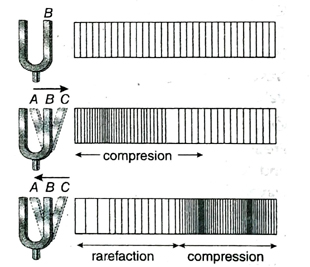
One full vibration takes place when the arm of the tuning fork goes from A to C and again from C to A. Thus, due to vibration (half-vibration) of the arm of the tuning fork from A to C, a compression of air adjoining the arm is produced and due to vibration (half-vibration) of the arm of the tuning fork from C to A, a rarefaction of air adjoining the arm is produced.
An long as vibration of the tuning fork continues, compressions and rarefactions are created periodically and these move through the medium. In this way, sound propagates through air.
VERY SHORT ANSWER TYPE QUESTIONS
Choose the correct answer
1. When sound is produced by mouth, vibration is observed in
A. vocal chords
B. pharynx
C. trachea
D. cochlea
Ans. A
2. If sound is made at one end of a long pipe, how many times is it heard at the other end?
A. once
B. twice
C. thrice
D. four times
Ans. B
3. Sound waves can propagate through
A. gaseous medium only
B. solid and liquid mediums only
C. solid, liquid and gaseous mediums
D. vacuum
Ans. C
4. Velocity of a sound wave of wavelength 2 m is 350 m/s. What is its frequency?
A. 170 Hz
B. 175 Hz
C. 700 Hz
D. 350 Hz
Ans. B
5. The frequency of a tuning fork is 300 Hz. How much distance does a sound wave traverse during 20 vibrations of the fork? Velocity of sound in air is 333 m/s.
A. 11.1m
B. 33.3 m
C. 44.4 m
D. 22.2 m
Ans. D
6. Frequencies of two tuning forks are 100 Hz and 150 Hz respectively. The ratio of the wavelengths of the waves produced by them in air is
A. 2:3
B. 3:2
C. 4:9
D. 9:4
Ans. B
7. Propagation of sound waves through a medium like air may be compared to
A. compression and rarefaction of a spring
B. vibration of a string
C. waves generated in water
D. propagation of light waves
Ans. A
8. If time period is 0.2 s, what is the corresponding frequency?
A. 4 Hz
B. 5 Hz
C. 10 Hz
D. 20 Hz
Ans. B
9. Sound propagates fastest through which of the following mediums?
A. solid medium
B. liquid medium
C. gaseous medium
D. vacuum
Ans. A
10. Sound does not propagate at all through which of the following mediums?
A. solid medium
B. liquid medium
C. gaseous medium
D. vacuum
Ans. D
11. Sound is
A. longitudinal elastic wave
B. transverse elastic wave
C. electromagnetic wave
D. none of the above
Ans. A
12. Frequency of sound is measured in the unit
A. watt
B. erg
C. second
D. hertz
Ans. D
13. A simple pendulum takes 40 seconds to oscillate 20 times. Time period of oscillation of the pendulum is
A. 1 s
B. 2 s
C. 3 s
D. 4 s
Ans. B
14. A simple pendulum takes 40 seconds to oscillate 20 times. Frequency of oscillation of the pendulum is
A. 0.1 Hz
B. 0.2 Hz
C. 0.3 Hz
D. 0.5 Hz
Ans. D
15. Production of sound requires
A. vibration of the source of sound
B. solid medium
C. the presence of audience
D. the presence of a reflector
Ans. A
16. Propagation of sound requires
A. vibration of the source of sound
B. solid medium
C. the presence of audience
D. the presence of a reflector
Ans. B
17. It has been proved experimentally that the velocity of sound in air at 0°C is approximately
A. 332 m/s
B. 442 m/s
C. 1080 m/s
D. zero
Ans. A
18. When velocity of sound in air at 0°C is 332 m/s, then which of the following cannot be the velocity of sound through a solid medium at the same temperature?
A. 300 m/s
B. 400 m/s
C. 500 m/s
D. 1000 m/s
Ans. A
19. Air comes out of lungs and enters larynx through
A. vocal chords
B. pharynx
C. trachea 1
D. heart
Ans. C
20. Sound wave is a longitudinal wave. So vibration of the source of sound is
A. longitudinal
B. transverse
C. longitudinal or transverse
D. none of the above
Ans. C
Answer in brief
1. What type of wave is a sound wave?
Ans. Sound wave is a longitudinal elastic wave.
2. Can sound wave propagate through vacuum?
Ans. No, sound wave cannot propagate through vacuum.
3. What is a sonorous body?
Ans. A body which acts as a source of sound is called a sonorous body.
4. How does the sound produced from the vocal chords of a human being change?
Ans. If there is change of tension of the two vocal chords or there is a change in air flow while breathing, then different types of sound are produced.
5. How can one talk on the surface of the moon?
Ans. One has to take the help of walkie-talkie to talk on the surface of the moon.
6. The velocity of sound is highest in which gaseous medium?
Ans. Velocity of sound is highest in hydrogen gas.
7. How is sound produced in guitar, sitar and violin?
Ans. Sound is produced in these instruments due to vibration of strings.
8. How is sound produced in a flute?
Ans. Sound is produced in a flute due to vibration of air particles inside the flute.
9. How is sound produced in human larynx?
Ans. Sound is produced in human larynx due to vibration of the two elastic vocal chords present in the larynx.
10. Which muscle controls the elasticity of two vocal chords of a human being?
Ans. A muscle named thyroarytenoid controls the elasticity of the vocal chords.
11. Among iron, water and air, velocity of sound is maximum in which medium?
Ans. Velocity of sound is maximum in iron.
12. Among iron, water and air, velocity of sound is minimum in which medium?
Ans. Velocity of sound is minimum in air.
13. If a sound is made at one end of a long iron pipe, we hear sound twice at the other end (due to the two mediums, iron and air). Which sound is heard at first?
Ans. The sound which is transmitted through iron is heard at first.
14. Between the motion of the arm of a clock and the motion of a simple pendulum, which one is a periodic motion but not a linear simple harmonic motion?
Ans. The motion of the arm of a clock is a periodic motion but it is not a simple harmonic motion.
15. Which wave progresses parallel to the movement of particles oscillating in a material medium?
Ans. Longitudinal wave progresses in a direction parallel to the movement of particles oscillating in a material medium.
16. Which wave progresses perpendicular to the movement of particles oscillating in a material medium?
Ans. Transverse wave progresses in a direction perpendicular to the movement of particles oscillating in a material medium.
17. Can longitudinal waves propagate through solid, liquid and gaseous mediums?
Ans. Yes, longitudinal waves can propagate through solid, liquid and gaseous mediums.
18. Can transverse waves propagate through solid, liquid and gaseous mediums?
Ans. No, transverse waves can propagate only through solid medium.
19. Which length is considered as a wavelength in case of a longitudinal wave?
Ans. Total length of one compression and one rarefaction is taken as a wavelength in case of a longitudinal wave.
20. Which length is considered as a wavelength in case of a transverse wave?
Ans. The distance between two successive crests or two successive troughs is taken as a wavelength in case of a transverse wave.
21. What is the relationship between propagation of a sound wave and medium?
Ans. Sound wave can propagate only through an elastic medium.
Fill in the blanks
1. Sound is a ………. elastic wave.
Ans. longitudinal
2. Any particle moving with linear simple harmonic motion periodically traverses the same path in ……….
Ans. opposite direction
3. Transverse waves propagate only through solid medium because a solid medium can resist the change of its ……….
Ans. shape
4. Light wave can propagate through vacuum because it is a type of ………. wave.
Ans. electromagnetic
5. The reciprocal of time period is ……….
Ans. frequency
6. ………. is the number of complete oscillations made by an oscillating particle in one second.
Ans. frequency
7. Velocity of sound in air at 0°C is ……….
Ans. 332 m/s
8. During the propagation of ………. waves, the layers of the medium come very close to each other and the phenomenon is known as compression.
Ans. longitudinal
9. During the propagation of transverse waves, ………. and ………. are produced in a cyclic order.
Ans. crests, troughs
10. ………. waves propagate in a direction perpendicular to the direction of motion of the particles of the medium.
Ans. transverse
11. ………. waves propagate in a direction parallel to the direction of motion of the particles of the medium.
Ans. longitudinal
12. Velocity of sound waves is ………. compared to the velocity of light waves.
Ans. less
13. The unit of frequency is ……….
Ans. hertz (Hz)
14. If the time period of a sound wave is 0.05s, its frequency is ……….
Ans. 20Hz
State whether true or false
1. Sound is a type of transverse elastic wave which is produced due to the vibration of a body.
Ans. False
2. Sound waves do not need any material medium for their propagation.
Ans. False
3. Production and propagation of mechanical waves depend on the cohesive property of the material medium.
Ans. True
4. Longitudinal waves propagate in a direction perpendicular to the motion of the vibrating particles of a material medium.
Ans. False
5. Alternate compressions and rarefactions generate during the propagation of a longitudinal wave.
Ans. True
6. Velocity of sound is highest in gaseous medium.
Ans. False
7. Wavelength of sound wave is much larger than that of light wave.
Ans. True
8. Sound is a kind of electromagnetic wave.
Ans. False
9. Velocity of sound wave does not changes with the change of medium.
Ans. False
10. Speed of light and speed of sound are same in a medium.
Ans. False
11. Sound propagates in air medium in the form of longitudinal waves.
Ans. True
TOPIC – B
Some Properties of Sound and Characteristic of Sound
SHORT AND LONG ANSWER TYPE QUESTIONS
1. Write down the laws of reflection of sound.
Ans. The laws of reflection are:
- The incident sound wave, the reflected wave and the normal to the reflector at the point of incidence, all lie on the same plane.
- The angle of incidence is equal to the angle of reflection.
2. Demonstrate with an experiment that during reflection of sound, angle of incidence angle of reflection.
Or, Demonstrate by an experiment that sound wave is reflected similar to a light wave.
Ans. Two hollow long pipes, open at both ends, are taken. Also, one table clock and one raised partition are taken. One long table is kept touching the wall and at a little distance from the wall, the partition is kept in a perpendicular way. Now, the pipes are kept on the two sides of the partition in such a way that the axes of both the pipes intersect at the point O of the wall [Fig.].
Now, a table clock is kept at the end A of the left pipe. The right pipe is now rotated slowly with respect to the point O so that a position is obtained, where tick tock sound of the clock is heard loudly. Suppose, sound is heard loudly at the point D. This is the reflected sound. The tick tock sound of the clock passes through the pipe AB, reflected at the point O and comes to the ear through the pipe CD and is heard. Now pencil marks are made at the points O, A, D and E. Next, pipe and partition are removed and A, O ; D, O; E, O are connected. If ∠AOE and ∠DOE are measured, it is found that ∠AOE = ∠DOE, i.e., angle of incidence = angle of reflection.
So, it can be concluded that sound wave is reflected similar to a light wave.
3. How is the property of reflection of ction of sound utilised in a stethoscope?
Ans. Stethoscope is a medical instrument using which doctors examine the heart or lungs of a patient. There are two rubber pipes in this instrument which are attached to a round metallic disc covered with a thin diaphragm. If the two open ends of the rubber pipes are fitted in the ears and the disc is placed on the chest of the patient, sound of the heart of the patient is reflected repeatedly through the rubber tubes and reaches the ears of the doctor.
4. Why do we curve our palm by the side of our ear to clearly hear a faint sound from a distant place?
Ans. To clearly hear a faint sound from a distant place, we curve our palm by the side of our ear. In addition to the direct faint sound, sound reflected from the palm also enters the ear. As a result, loudness of the sound increases to some extent. Here, palm of the hand works like a concave reflector.
5. Why is the roof of a modern auditorium curved like an arch?
Ans. The roof of a modern auditorium is curved like an arch so that it works as a concave reflector and if the source of sound is kept at its focus, sound spreads evenly throughout the auditorium. As a result, loudness of the sound increases.
6. How can one talk in a speaking tube?
Ans. If we talk at one end of a long metallic tube, the produced sound advances through the tube without scattering and reaches the other end after repeated reflections. The listener on the other side hears this sound very clearly. This arrangement is called a speaking tube. A funnel is attached to the front side for the speaker.
7. What do you mean by audible sound?
Ans. One can hear sound only when the number of vibrations per second, i.e., frequency of a vibrating body lies within the range of 20 Hz to 20000 Hz. This sound is called audible sound.
8. What do you mean by infrasonic sound and ultrasonic sound. Give examples,
Ans. Infrasonic sound is the sound whose frequency is less than 20 Hz.
Ultrasonic sound is the sound whose frequency is more than 20 kHz.
When a pendulum oscillates, its frequency remains less than 20 Hz. Sound produced in this case is infrasonic sound, hence inaudible. Again, when a bat flies, it produces a type of sound from its mouth whose frequency is more than 20 kHz, that is, ultrasonic sound.
9. A flying bat makes a sound from its mouth. What type of sound wave does it produce?
Ans. The sound wave emitted by a flying bat from its mouth has a frequency more than 20 kHz. Hence, it is an ultrasonic sound. If there is any obstacle in front of the sound, sound waves get reflected. By hearing that reflected sound, the bat can locate the position of any obstacle. We can not hear this ultrasonic sound emitted from the mouth of a bat.
10. Give some practical applications of ons of ultrasonic sound.
Ans. These are some of the practical applications of ultrasonic sound:
- In the process of ultrasonography, ultrasound is used to detect the location of a tumour in a human body.
- Ultrasonic sound is used to clean dirty clothes.
- Ultrasonic sound is also used to measure depth of sea, to locate submarine or a shoal of fish or to understand the presence of aquatic animals inside sea.
11. Mention two applications of ultrasonic cations of ultrasonic sound in medical science.
Ans. It has been confirmed by experiments that there are some bacteria which can be destroyed by the application of ultrasonic sound. Also in the process of ultrasonography or USG, ultrasonic sound is used to know more about the internal muscles, different joints, arteries etc. of the body.
12. Write about a few animals in nature who normally make use of ultrasonic sound con su in their manner of living.
Ans. It has been observed that animals like bats, dolphins, whales etc. utilise ultrasonic sound. Bats emit ultrasonic sound of very high frequency (100 kHz-200 kHz) from their mouth at the time of flying. This sound is reflected back from some obstacle in front of it and this helps the bat in recognising the obstacle. It thus flies freely without any impediment. Whales, dolphins etc. living deep inside the sea communicate with each other through the use of ultrasound.
13. Light wave ht wave is re reflected regularly from a small and smooth reflector whereas sound wave is not reflected. Why?
Ans. Reflection of a wave is possible only when the size of the reflector is larger than its wavelength. Again, whether reflection of a wave is regular or scattered, depends on roughness of the surface of the reflector. If the wavelength of the wave is greater than the roughness of the surface of the reflector, there is regular reflection, otherwise the reflection is scattered.
Wavelength of sound in the audible range is from 1.5 cm to 16 m and wavelength of light in the visible range is from 1000 Å (or 4 × 10-5 cm) to’ 8000 Å (or 8 × 10-5 cm). The size of a small, smooth reflector is comparatively larger than the wavelength of visible light. So, in this case, light is reflected and the value of roughness being less than the wavelength of light, the reflection is regular. But as the size of a reflector is smaller than the wavelength of a sound wave, there is no reflection of sound wave.
14. On a particular da day, wind is bl blowing from east to west. A song is played through a microphone. A man is standing slightly away from the microphone in the east. Now, this man crosses the microphone and moves to the west side of the microphone at an equal distance. He hears more intense sound in which case? Explain with reasons.
Ans. Sound spreads in every direction with equal loudness. But if wind blows along the direction of propagation of sound, loudness increases in that direction. According to this question, wind blows from east to west. As a result, the man hears sound with greater intensity while standing in the west.
15. What do you mean by pitch of a sound?
Ans. If a male, a female and a child pronounce a sound with the same intensity, this same sound is known to create three different feelings in our ears. The voice of a female appears to be shriller than that of a male, again the voice of a child appears to be shriller than that of a female. This characteristic of sound is called pitch.
Pitch is defined as that characteristic of a musical sound due to which a listener can differentiate between a high-pitched and a low-pitched sound.
16. Explain the statement – frequency is the cause of a sound and pitch is its effect.
Ans. Pitch depends mainly on frequency. If the frequency of a tone is high, its pitch is also high. On the other hand, if frequency is low, pitch is also low. So, it is said that frequency is the cause and pitch is the effect.
But frequency is a physical quantity and is measurable whereas pitch is a feeling which is not measurable.
17. Loudness and pitch of sound change mainly due to which physical quantities?
Ans. Due to change of intensity of a musical sound, loudness of sound perceived by a person changes. It has been found by experiment that this sensation increases as intensity of sound increases.
On the other hand, due to change in frequency of a musical sound, the pitch of a sound perceived by ear changes. Generally, as the frequency of the source of sound increases, the sound appears to be more high-pitched in the ears of an individual.
18. What do you mean by quality or timbre you mean by quality of of a sound?
Ans. The characteristic property by which sound of same intensity and pitch emitted by different sources can be distinguished is called the quality or timbre of a musical sound. Due to this characteristic of sound, tones of the same intensity and pitch emitted from harmonium, violin and table etc. can be easily differentiated by us.
19. The quality or timbre of a note depends on which factors?
Ans. The quality of a note depends on three factors. These are:
(1) the number of overtones mixed with the fundamental tone; (2) frequencies of the overtones and (3) relative intensity of the overtones.
VERY SHORT ANSWER TYPE QUESTIONS
Choose the correct answer
1. Due to which characteristic of sound, one can distinguish between low-pitched and high-pitched sound of same intensity?
A. loudness
B. amplitude
C. frequency
D. pitch
Ans. D
2. Which one is the first harmonic among the following frequencies: 500 Hz, 900 Hz, 550 Hz, 750 Hz, 300 Hz, 600 Hz ?
A. 300 Hz
B. 500 Hz
C. 600 Hz
D. 900 Hz
Ans. A
3. Out of 256 Hz, 512 Hz, 1020 Hz and 1280 Hz, the frequency 1280 Hz is the
A. last tone
B. fourth overtone
C. third harmonic
D. second harmonic
Ans. B
4. Intensity of sound does not depend on
A. shape of the source of sound
B. amplitude of vibration of the source of sound
C. density of the medium
D. number of overtones in note
Ans. D
5. The sound which contains more number of ……….. is more melodious.
A. harmonics
B. overtones
C. fundamental tones
D. beats
Ans. A
6. Characteristic of musical sound is
A. loudness
B. pitch
C. quality
D. all of these
Ans. D
7. The quantity which does not produce any perception is
A. loudness
B. intensity
C. pitch
D. quality
Ans. B
8. Among the following pairs, which one represents reciprocal quantities?
A. frequency and wavelength
B. frequency and time period
C. velocity of wave and wavelength
D. wavelength and loudness
Ans. B
9. Which of the following cannot reflect sound waves?
A. range of mountains
B. high embankment of a river
C. a small mirror
D. wall of an empty hall
Ans. C
10. Reverberation of sound may be heard
A. in a stethoscope
B. inside an empty hall
C. in a distant wall
D. in vacuum
Ans. B
11. Reverberation of sound is created
A. in one reflection
B. in two reflections
C. in three reflections
D. in multiple reflections
Ans. D
12. Rubber pads are fixed on the walls of a cinema hall in order to
A. increase reflection of sound
B. decrease reverberation of sound
C. increase velocity of sound
D. increase loudness of sound
Ans. B
13. If a tuning fork is struck, sound emitted from it has a frequency of 500 Hz . What is the frequency of the emitted sound when the tuning fork is struck with twice the previous force?
A. 1000 Hz
B. 500 Hz
C. 250 Hz
D. insufficient data
Ans. B
14. Which of the following is essential for a melodious sound?
A. presence of more harmonics
B. presence of more overtones
C. presence of different frequencies
D. presence of different musical instruments
Ans. A
15. Which of the following statements is correct?
A. Tone is a sound of single frequency
B. Note is a sound of single frequency
C. Tone is a sound composed of different frequencies
D. Tone is composed of several notes
Ans. A
16. If the frequency of the source of sound increases, the sound heard by a person appears to be more
A. loud
B. discordant
C. melodious
D. shrill
Ans. D
17. If the velocity of sound in air at 27°C is 348 m/s, then what is the minimum distance between the source and the reflector of sound to hear an echo of transient sound?
A. 17.4 m
B. 34.8 m
C. 69.6 m
D. 104.4 m
Ans. A
18. If the velocity of sound in air at 27°C is 348 m/s, what is the minimum distance between the source and the reflector of sound to hear an echo of a monosyllabic sound?
A. 17.4 m
B. 34.8 m
C. 69.6 m
D. 104.4 m
Ans. B
19. Bats detect the obstacles in their path by receiving the reflected
A. electromagnetic waves
B. radio waves
C. infrasonic wave
D. ultrasonic waves
Ans. D
20. Infrasonic sound can be heard by
A. human beings
B. dolphins
C. rhinoceros
D. monkey
Ans. C
21. Which of the following is used in ultrasonography?
A. Infrasonic sound
B. ultrasonic sound
C. audible sound
D. radio waves
Ans. B
22. Which of the following is used in SONAR?
A. infrasonic sound
B. micro waves
C. ultrasonic sound
D. audible sound
Ans. C
23. Repeated reflection of sound produces
A. Reverberation
B. stationary wave
C. echo
D. refraction
Ans. A
24. A mirror is a good reflector of light wave but poor reflector of sound wave because
A. wavelength of sound is bigger than the mirror
B. wavelength of light is bigger than the mirror
C. velocity of sound is smaller than that of light
D. sound can not travel in vacuum
Ans. A
25. A supersonic jet plane
A. can fly faster than sound
B. can fly at the highest velocity of sound
C. cannot fly with the velocity of sound
D. can fly with the velocity of light
Ans. A
26. A jet plane is flying with supersonic speed. Its Mach number is
A. equal to one
B. more than one
C. less than one
D. equal to one hundred
Ans. B
Answer in brief
1. What is the range of frequency of audible sound?
Ans. Range of frequency of audible sound is 20 Hz to 20000 Hz.
2. What is the frequency of infrasonic sound?
Ans. Frequency of infrasonic sound is less than 20 Hz.
3. What is the frequency of ultrasonic sound?
Ans. Frequency of ultrasonic sound is more than 20000 Hz.
4. What is a tone?
Ans. Sound of a single frequency is known as a tone.
5. What is a note?
Ans. Note is a sound containing more than one frequency.
6. Give one application where principle of echo is utilised.
Ans. Hearing aid.
7. 500 Hz is written on the body of tuning fork. Is the sound produced from this fork a tone or a note?
Ans. If the tuning fork is vibrated, the sound produced from it is a tone since sound of only 500 Hz frequency is produced.
8. Which property of sound is applied in a doctor’s stethoscope?
Ans. Property of reflection of sound is applied in a doctor’s stethoscope.
9. What type of sound is emitted when a tuning fork is struck?
Ans. Audible sound is emitted when a tuning fork is struck.
10. What type of sound is used in the in a radar?
Ans. Ultrasound is used in a radar.
11. Mention the name of an animal which makes use of ultrasound.
Ans. A bat uses ultrasound while flying.
12. Which characteristic of a musical sound depends on its frequency?
Ans. Pitch of a musical sound depends on its frequency.
13. Which characteristic of a musical sound depends on its intensity?
Ans. Loudness of a musical sound depends on its intensity.
14. Which characteristic of a musical sound changes when the distance between the source of sound and the listener changes?
Ans. In this case, loudness of the musical sound changes.
15. Sound of the same frequency and with the same intensity are emitted from different string instruments. Which characteristic of sound helps us in distinguishing the sound of one musical instrument from the other?
Ans. Quality or timbre of the musical sound helps us in distinguishing the sound of different musical instruments.
16. Which is the first harmonic in a sound consisting of more than one frequency?
Ans. The sound with the minimum frequency is the first harmonic.
17. What do you mean by the intensity of sound?
Ans. A Sound energy per unit time per unit area is known as the intensity of sound.
18. What does SONAR stand for?
Ans. SONAR stands for SOund Navigation And Ranging.
19. What is the basic principle with which SONAR works?
Ans. SONAR works on the principle of reflection of waves.
20. State one important use of ultrasound in industries.
Ans. Ultrasounds are used to find faults and cracks in metal.
21. State one important use of ultrasound for medical purpose.
Ans. Diagnosing the diseases in human body,
22. What do you understand by the reverberation?
Ans. The phenomenon of prolongation of original sound due to the multiple reflection of sound wave even after the source stops producing sound is called reverberation.
23. Why is the speed of sound grater in solid than in gas?
Ans. This is because particle of solids are closer than the particles of gases.
24. Which wave property determines loudness?
Ans. Amplitude of the wave determines loudness.
25. Does sound follow the same lows of reflection as light does?
Ans. Yes. Sound wave are reflected just like light wave.
26. Why is sound not heard when a bird flies?
Ans. When a bird flies, the frequency of its wings is less than 20 Hz which is in the infrasonic range and thus the sound cannot be heard.
27. How does the velocity of sound in air change when temperature is increased?
Ans. Velocity of sound in air increases when temperature is increased.
28. How does the velocity of sound in air change when humidity of air increases?
Ans. Velocity of sound in air increases when the humidity of air increases.
29. When a pendulum oscillates, its frequency remains less than 20 Hz. What type of sound is produced in this case?
Ans. Infrasonic sound is produced in this case.
30. Which type of sound waves are used to clean dirty clothes?
Ans. Ultrasonic sound waves are used to clean dirty clothes.
31. Which type of sound waves are used to detect a shoal of fish deep inside sea water?
Ans. Ultrasonic sound waves are used to detect a shoal of fish deep inside sea water.
Fill in the blanks
1. The perception of difference of pitch sound arises due to change of …………. of sound.
Ans. frequency
2. In the case of …………. , repeated reflection of sound occurs.
Ans. reverberation
3. Sound having frequency more than the frequency of the audible range is known as …………. sound.
Ans. ultrasonic
4. Sound having frequency less than the frequency of the audible range is known as …………. sound.
Ans. infrasonic
5. Stethoscope is the application of the property of …………. of sound.
Ans. reflection
6. Soft pads fixed to the walls of different auditoriums serve as ………….
Ans. sound absorbers
7. SONAR uses …………. sound to determine the depth of an ocean.
Ans. ultrasonic
8. …………. of sound increases with the increase of size of the source of sound.
Ans. Intensity
9. …………. of the sound increases with increase of frequency of the source of sound.
Ans. pitch
10. The intensity of sound …………. if air flows along the direction of motion of the sound.
Ans. increases
11. The difference in the voices of males and females is due to the …………. of sound.
Ans. pitch
12. Reflection of a wave is possible only when the size of the reflector is …………. compared to the wavelength of the wave.
Ans. greater
13. The trace of a sound remains in our brain for almost ………….
Ans. 0.1 s
14. The ratio of the velocities of a body and sound in a medium is called ………….
Ans. Mach number
15. The velocity of a moving body is called …………. if the value of its Mach number is more than 1.
Ans. supersonic
State whether true or false
1. Echo and reverberation of sound refer to a single phenomenon.
Ans. False
2. SONAR is an acronym for Sound Navigation and Ranging.
Ans. True
3. The tone having the lowest frequency in a note is known as fundamental tone.
Ans. True
4. Ultrasonic sound is used for the purpose of sterilizing of milk.
Ans. True
5. Loudness of sound varies inversely to the square of the amplitude.
Ans. False
6. Pitch of note depends on its amplitude.
Ans. False
TOPIC – C
Human Ear and Sound Pollution
SHORT AND LONG ANSWER TYPE QUESTIONS
1. What are the functions of a human ear?
Ans. There are two major functions of a human ear: (1) hearing and (2) maintaining balance of the body.
2. Draw a sim a simple figure depicting different parts of a human ear.
Ans. The figure depicting different parts of a human ear is shown below:
3. Describe the structure and function of the outer ear of a human being.
Ans. The outer portion of the ear is called outer ear. It consists of three parts- (1) pinna (2) auditory canal and (3) tympanic membrane or eardrum.
Pinna is made up of a thin plate of yellow elastic cartilage and soft tissue and is situated on two sides of the head. At the centre of the pinna, there is a hole which is connected with a 3 cm long zigzag canal named auditory canal which extends up to the eardrum (tympanic membrane). The tympanic membrane is situated at the end of the auditory canal and is an elastic membrane mainly made up of muscles.
The pinna of ear collects external sound waves and reflects it to auditory canal. Sound waves, after passing through the auditory canal, create vibration on the tympanic membrane.
4. What is pinna or auricle?
Ans. This is a portion of the outer ear protruded outwardly on two sides of the head. It is made up of a thin plate of yellow elastic cartilage, covered with integument, and connected to the surrounding parts by ligaments and muscles.
5. Describe the structure and function of the middle ear of a human being.
Ans. In between the outer ear and the inner ear, there lies the middle ear which consists of a small air-filled cavity and is made up of three adjacent bones – malleus, incus and stapes. As middle ear is connected with pharynx through eustachian tube, air pressure remains the same inside and outside the middle ear.
The vibrations that are created by an external sound wave in the eardrum enters the inner ear through the bones of the middle ear.
6. Describe the structure and function of the inner ear of a human being.
Ans. Inner ear consists mainly of vestibular apparatus and cochlea. There are three semicircular canals in the vestibular apparatus. These semi circular canals are filled up with a liquid named endolymph. Cochlea is the last part of the inner ear and looks like a coiled tube similar to a snail. The organ which acts as the receptor of sound in cochlea is called organ of Corti. It is a hairy instrument with three compartments filled with endolymph.
When sound wave reaches cochlea, organ of Corti is stimulated and this stimulation reaches the hearing centre of the brain through auditory nerves and creates the sensation of hearing.
7. What is the role of ear in sending sound waves?
Ans. The pinna of the ear collects external sound waves and reflects it to external auditory canal. It gathers sound energy and focuses it on the eardrum to vibrate it. This vibration on the eardrum created by the external sound waves enters the inner ear through three tiny bones – malleus, incus and stapes of the middle ear. When sound reaches the cochlea of inner ear, organ of Corti is stimulated and this stimulation reaches the hearing centre of the brain through auditory nerves and creates the sensation of hearing.
8. What is eustachian tube? What is its eustachian tube? What is function?
Ans. It is a narrow passage from the pharynx to the cavity of the middle ear. It is a canal that connects the middle ear to the pharynx.
Its main function is to maintain equilibrium of the air pressure between the inside and outside of the ear. Its secondary function is to clear any accumulated secretion, infection or debris from the space of the middle ear.
9. What do you mean by sound pollution?
Ans. The harmful effect of undesirable sound on the environment is known as sound pollution. Undesirable sound refers to sound with high loudness and pitch and beyond the tolerance level of the ear. Sound produced from different factories, horns of traffic, loudspeakers used in various functions, fire-crackers, take-off and landing of aircrafts, loud sound from radio, television, siren etc. create sound pollution in the environment. Further, natural sources like sound of lightning, rumbling of cloud also add to sound pollution.
10. How does sound pollution happen in our daily lives?
Ans. In daily life, our hearing gets so used to different high-pitched sounds that we get tremendous relief when these sounds stop. Different aspects of our environment are responsible for mental and physical health of every animal on the planet. Sound is one of the key features among them. Different types of undesirable high-pitched sounds like noise, shouting, sound of microphones, sound of cars, sound of air-horns, sound of generators, metallic and mechanical sound of different factories and from different other sources get mixed together to disturb our normal life. If the same type of disturbance continues in the same area regularly, it creates sound pollution. Mental and physical health is affected due to this sound pollution.
11. Discuss in brief, the harmful effects of sound pollution on the animal world of the earth.
Ans. It has been observed in very recent research works that not only human beings but also other animals are badly harmed due to sound pollution created by humans.
Research has proved that a particular species of frog is used to hear call of a specific low frequency from their friends. But due to sound pollution, the frogs are forced to communicate with other frogs in high frequency sound which disrupts their normal livelihood. Birds also suffer due to the same reason.
Harmful effects of sound pollution extend to deep sea also. Normal lives of whales, dolphins, fish etc. suffer enormously due to ultrasonic sounds from SONAR emitted on account of scientific research in deep seas.
12. Discuss the harmful effects of sound pollution in daily life.
Ans. Sound pollution is harmful to human beings, both physically and mentally. It has been observed that the hearing power of a man is damaged if high-pitched sound is heard continuously for a long time. In extreme cases, it may also lead to deafness. High-pitched sound may increase blood pressure, create heart problems, affects concentration of mind and also memory. Work efficiency gradually decreases if a person is a victim of sound pollution due to professional reasons. Sound pollution is an important cause of insomnia.
13. Discuss some ways to control the sound pollution in our daily lives.
Ans. Ways to control the sound pollution in our daily lives are:
- By increasing awareness among the citizens regarding sound pollution and its bad effects.
- By taking preventive measures in factories regarding sound pollution.
- By making laws regarding sound pollution and implementing those rigorously.
- By prohibiting the use of loudspeakers and horns of car near schools, colleges, hospitals etc.
- By constructing factories and airports away from the residential areas.
VERY SHORT ANSWER TYPE QUESTIONS
Choose the correct answer
1. ‘Decibel’ unit is used to measure
A. loudness
B. frequency
C. wavelength
D. time period
Ans. A
2. What is the safe intensity level of sound indicated by World Health Organisation (WHO)?
A. 45 dB
B. 65 dB
C. 80 dB
D. 90 dB
Ans. A
3. What is the sound intensity level of perception?
A. 100 dB
B. 110 dB
C. 120 dB
D. 140 dB
Ans. C
4. What is the threshold of hearing for sound with frequency 1000 Hz ?
A. 10-9 W/m²
B. 10-10 W/m²
C. 10-11 W/m²
D. 10-12 w/m²
Ans. D
5. What is the limit of perception for sound of frequency 1000 Hz ?
A. 1 W/m²
B. 1.5 W/m²
C. 2 W/m²
D. 10 W/m²
Ans. A
6. What is the persistence time of hearing?
A. 0.05 s
B. 0.1 s
C. 0.2 s
D. 1 s
Ans. B
7. It is the function of ………… to collect and centralise sound waves.
A. pinna
B. auditory canal
C. tympanic membrane or eardrum
D. tympanic cavity
Ans. B
Answer in brief
1. Which quantity has its unit as decibel?
Ans. Decibel (dB) is the unit of difference of intensity level of sound.
2. Between loudness and intensity of sound, which one is a measurable quantity?
Ans. Intensity of sound is a measurable quantity.
3. Where is the organ of Corti located?
Ans. Organ of Corti is located in the cochlea of the inner ear.
4. What is endolymph?
Ans. Endolymph is a liquid which is present in the scalamedia cavity of cochlea in the inner ear in which organ of corti remains immersed.
5. Where is semicircular canal located in the ear?
Ans. Semicircular canal is located in the inner ear.
6. What is basilar membrane?
Ans. Basilar membrane is a membrane in cochlea on which the organ of Corti is located.
7. What is the function of the auditory canal of the ear of a human being?
Ans. Auditory canal of the ear collects and focuses sound waves.
8. What is the function of tympanic cavity of the ear of a human being?
Ans. Waves created on the tympanic membrane vibrate the air of the tympanic cavity and sound waves move forward towards the next portion of the ear.
9. What is the function of eustachian tube of the ear of a human being?
Ans. The eustachian tube maintains the equilibrium of air pressure between the inside and the outside of the middle air.
10. What are the three bones of the middle ear?
Ans. The three bones of the middle ear are malleus, incus and stapes.
11. What is the function of ear other than hearing?
Ans. In addition to hearing, ear maintains balance of the body.
Fill in the blanks
1. ……….. maintain air pressure in the middle ear.
Ans. Eustachian tubes
2. The unit of the difference of intensity levels of sound is …………
Ans. bel
3. Ear can mainly be divided into ………… parts.
Ans. three
4. Sound waves reach the auditory centre of the brain through ………. nerves.
Ans. auditory
5. The unit of intensity of sound is ………….
Ans. W/m²
6. The safe level of noise is …………. dB.
Ans. 65 dB
7. The part of human ear that collects the sound and send it to the auditory canal is …………
Ans. pinna
8. The vibrations produced by the eardrum are amplified by the ………… , …………. and …………
Ans. hammer, anvil, the strrup
9. The …………. is a coiled and fluid filled tube having the sense organ of hearing.
Ans. cochlea
State whether true or false
1. The ear only help us to hear.
Ans. False
2. Eustachian tube maintains pressure balance in the two sides of ear drum.
Ans. True
3. The three ossicles the hammer, anvil and the stirrup are located at the inner ear.
Ans. False
4. The cochlea is a coiled and fluid filled tube.
Ans. True
5. The organ of corti is located in the mammalian cochlea.
Ans. True
6. The incus receives vibrations from sound pressure on the ear drum.
Ans. False
7. Zero level sound intensity is 10-12 W. m-2.
Ans. True
8. The safe level of noise as specified by the central pollution control board is 120 dB.
Ans. False
